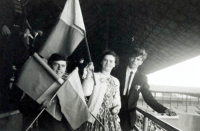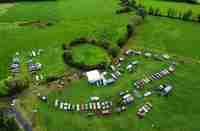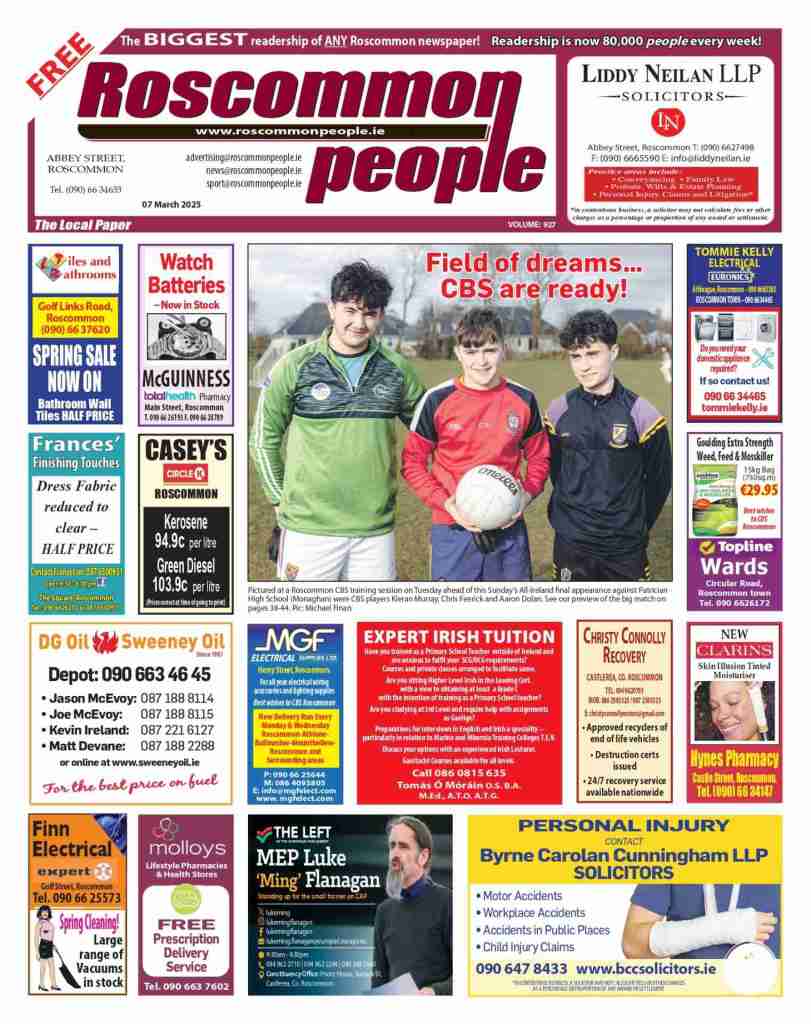The War of Independence in Roscommon
(100 years ago; September 1920)
The month of September 1920 proved to be a bloody month in County Roscommon during the War of Independence, with barrack attacks, ambushes and shootings.
On the 1st of the month an ambush occurred in the townland of Teevnacreeva in the parish of Tibohine, on the road between Frenchpark and Ballaghaderreen.
Volunteers from east Mayo and south Sligo, along with some local men, had planned a bloodless coup where a number of RIC men were to be held up and disarmed of their weapons. On the day of the proposed hold-up a five-man unit of the RIC approached from Ballaghaderreen on bicycles. They were fully armed with rifles and revolvers and were on their way to Frenchpark where the September district court was in session.
The whole plan became undone when one of the hold-up party fired at a policeman’s back wheel to prevent him from passing by; the police immediately jumped off their bicycles and returned fire. In the brief fire-fight, two RIC men lost their lives and one IRA member was killed.
The volunteer who met his death was Thomas McDonagh, (who was born in the U.S. but then resident of Cloonloo, County Sligo) and he became the first casualty suffered by the IRA in Roscommon during the War of Independence. It was discovered later that McDonagh’s revolver had faulty ammunition and had misfired, resulting in him being unable to defend himself from the opposing fire. The ambush proceeds included rifles, revolvers and ammunition, equipment much needed by the volunteers.
In the aftermath of the attack, the Black and Tans descended on the scene and seized the body of Thomas McDonagh. They placed it on a lorry and brought it into Ballaghaderreen. They then tied the body to the rear of the lorry and had it dragged through the streets of the town. Thomas McDonagh’s remains were eventually released after his relatives and his fiancée pleaded with the authorities for possession. The Black and Tans would further exact their revenge for the ambush later in the year, as will be detailed in further articles.
September also saw the first random killing by the Black and Tans of an innocent civilian. On September 10th, Patrick Gill, a 44-year-old farmer from Corlara, Kilmore was on the way to pay his respects to the relatives of a dead neighbour in the village of Drumsna. He was accompanied by his sister and a friend. As they walked through the village a single shot rang out and Patrick Gill fell to the ground. He died instantly from a single bullet wound to the chest. The shot had been fired from a military vehicle parked on the street. He was the random victim of a Black and Tan patrol and was the first of many Roscommon citizens to fall victim of the terror during the period 1920/21.
In the west of the county tragedy struck a few days later. On the 14th of September members of the 1st Battalion South Roscommon Brigade laid plans for the destruction of the RIC barracks in Ballinlough. The building was vacated by the police and military that had been stationed there before they moved to the more fortified barracks in Castlerea. The volunteers were going to ensure that by burning the structure it wouldn’t be habitable again for some time. This practice of destroying vacated barracks had been going on since the spring and the Crown forces were aware that the Ballinlough building could suffer the same fate as the other barracks in the county.
The destruction operation was led by Pat Glynn, the battalion commander. The plan was to climb onto the roof with the aid of a ladder, break a hole in the slated roof, pour in some paraffin or petrol and set it on fire. On the night of the assault everything seemed to be going according to plan, Pat Glynn was on the ladder and others were on the ground. As soon as the first flames erupted from the building a hail of bullets pierced the night sky. British forces, through information received, were aware of the impending attack and had set a trap by concealing themselves behind a wall opposite the barracks. The light from the flames illuminated the area and made the IRA men easy targets for the soldiers. The volunteers had not been fully armed and weren’t expecting an onslaught of this kind, so they scattered to the darkness of the surrounding fields. When the firing ceased three men lay dead at the scene.
The three men who were killed were Pat Glynn, (Loughglynn) O/C of the 1st Battalion (Castlerea); Lt. Michael Glavey, (Ballinlough) a quartermaster with the battalion, and Michael J. Keane, (Ballinlough). The deaths of the three volunteers in Ballinlough that night was a severe blow to the IRA as it was the single greatest loss suffered by the movement so far in County Roscommon.
The bodies of the three men were taken from the scene by the military to Castlerea and held there until relatives came to identify them. When the families of the deceased went to identify the bodies they found them disrespectfully placed in a turf shed at the rear of the barracks. A few days later their funerals took place; Glavey’s in Ballyhaunis, Keane’s in Granlahan, and Glynn’s in Kilruddane, Loughglynn where a large crowd of people from all over Connacht attended the burial. After Patrick Glynn was laid to rest a formation of 1000 IRA members paraded in a field beside the graveyard where they were addressed by brigade officers.
In the 1930s Roscommon Co. Council passed a resolution naming the main streets of Ballinlough to the memory of the dead volunteers: The street leading to Granlahan is named Sráid Mhig Fhloinn, (Glynn Street), the street leading to Castlerea is named Sráid Chatháin, (Keane Street), and the street leading to Ballyhaunis is named Sráid Mhig Fhlaithimh, (Glavey Street). The GAA club of Gorthaganny is named ‘Michael Glavey’s’ in memory of the local volunteer.
More next month (An Staraí Áitiúil)






